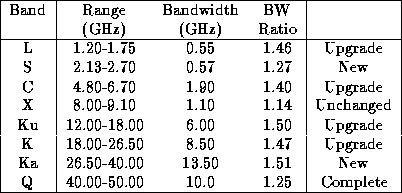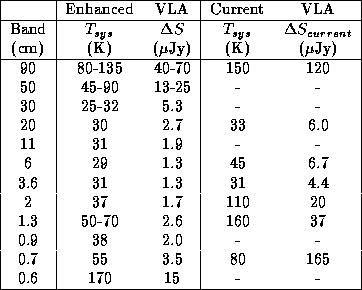Antenna and Receiver Improvements




Next: A New LO/IF
Up: TECHNICAL OVERVIEW
Previous: TECHNICAL OVERVIEW
At the antennas, the project involves: i) improving receivers at
existing observing bands; ii) adding new observing bands; and, iii)
modifying the antenna structure for improved operation.
The VLA receivers have been upgraded gradually since the early 1980s.
Initially, better low-noise amplifiers were used in existing
receivers. More recent systems have used the VLBA design, in which
the receiver is attached directly to the feed and the polarizer is
cooled in the cryogenic dewar. This design reduces the noise
contribution from the polarizer and eliminates long, ambient
temperature waveguide runs that added to the system temperature.
The ``VLBA-style'' receivers are now used at 1.4, 8.4, and 40-50 GHz.
These receivers will remain with perhaps only minor modification. The
greatest improvement in system temperature can be made in the 5, 15,
and 22 GHz bands using the VLBA-style receivers and modern HFET
amplifiers. Completely new receivers will be built for these bands,
and should reduce the system temperatures by up to a factor of 3. The
new receivers will also provide  GHz bandwidth per
polarization channel (needed for continuum sensitivity) and will tune
over a wider frequency range (to include spectral lines, e.g., methanol,
whose astrophysical significance was unknown when the VLA was built).
Current plans call for bandwidth ratios of order 1.4-1.5:1 in many
bands.
GHz bandwidth per
polarization channel (needed for continuum sensitivity) and will tune
over a wider frequency range (to include spectral lines, e.g., methanol,
whose astrophysical significance was unknown when the VLA was built).
Current plans call for bandwidth ratios of order 1.4-1.5:1 in many
bands.
At present, only ten VLA antennas are outfitted for 40-50 GHz
operation; this band will be made available on all antennas.
Two new receiver systems will be added at the Cassegrain focus:
2.4 GHz and 33 GHz. A stand-alone 2.4 GHz feed will fit on the feed
ring at the Cassegrain focus and will give higher performance than,
e.g., an 1.4 GHz/2.4 GHz dual-band feed such as that used on the
Australia Telescope. The 2.4 GHz band is potentially the highest
sensitivity VLA band. It will also let the VLA participate in
bistatic planetary radar observations with Arecibo Observatory. The
33 GHz band can also support bistatic radar experiments with the
Goldstone 70 m antenna and would allow imaging of many interesting
molecular lines, including red-shifted CO. Table 1.1 summarizes the
proposed new and upgraded VLA Cassegrain observing bands.

Table 1.1: Proposed VLA Cassegrain Observing Bands
Plans for new prime focus receiver systems are less well defined. A
330 MHz system is currently located at the prime focus, as is a
low-performance, dismountable 74 MHz system on 8 antennas. The
presence of the 74 MHz dipole feed degrades performance of the 1.4 GHz
band by about 10%. Hence, if 74 MHz feeds are deployed on all
antennas, it must be possible to dismount them (or otherwise move them
from the prime focus position by mechanical means).
Other specific proposals for prime focus systems include:
- A new system covering 580-640 MHz,
matching that of the VLBA.
- A broadband UHF (
 150-600 MHz) system, including a
low-performance system for solar work.
150-600 MHz) system, including a
low-performance system for solar work.
- A sensitive 800-1200 MHz system.

Table 1.2: VLA Sensitivity
Table 1.2 compares the continuum sensitivity of the current instrument
to that we hope to achieve. We assume a maximum useable bandwidth with
RFI excision at the lower frequencies, and add an atmospheric
contribution where relevant. The number under  refers to the
continuum sensitivity in microJy/beam achieved in 12 hrs integration,
summing over two orthogonal polarizations. The total bandwidth assumed
for 0.33, 0.60, 1.0, 1.4, and 2.4 GHz is 50, 100, 200, 500, and
1000 MHz, respectively. All other estimates assume 2 GHz net
bandwidth.
refers to the
continuum sensitivity in microJy/beam achieved in 12 hrs integration,
summing over two orthogonal polarizations. The total bandwidth assumed
for 0.33, 0.60, 1.0, 1.4, and 2.4 GHz is 50, 100, 200, 500, and
1000 MHz, respectively. All other estimates assume 2 GHz net
bandwidth.




Next: A New LO/IF
Up: TECHNICAL OVERVIEW
Previous: TECHNICAL OVERVIEW
newvla@nrao.edu
 GHz bandwidth per
polarization channel (needed for continuum sensitivity) and will tune
over a wider frequency range (to include spectral lines, e.g., methanol,
whose astrophysical significance was unknown when the VLA was built).
Current plans call for bandwidth ratios of order 1.4-1.5:1 in many
bands.
GHz bandwidth per
polarization channel (needed for continuum sensitivity) and will tune
over a wider frequency range (to include spectral lines, e.g., methanol,
whose astrophysical significance was unknown when the VLA was built).
Current plans call for bandwidth ratios of order 1.4-1.5:1 in many
bands.

 150-600 MHz) system, including a
low-performance system for solar work.
150-600 MHz) system, including a
low-performance system for solar work.

 refers to the
continuum sensitivity in microJy/beam achieved in 12 hrs integration,
summing over two orthogonal polarizations. The total bandwidth assumed
for 0.33, 0.60, 1.0, 1.4, and 2.4 GHz is 50, 100, 200, 500, and
1000 MHz, respectively. All other estimates assume 2 GHz net
bandwidth.
refers to the
continuum sensitivity in microJy/beam achieved in 12 hrs integration,
summing over two orthogonal polarizations. The total bandwidth assumed
for 0.33, 0.60, 1.0, 1.4, and 2.4 GHz is 50, 100, 200, 500, and
1000 MHz, respectively. All other estimates assume 2 GHz net
bandwidth.